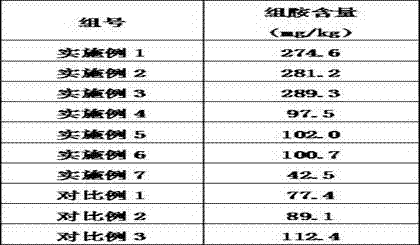Method for utilizing scallop rim materials to produce seasoning sauce
A technology for seasoning sauce and scallop trim, which is applied in the field of producing sauce by using scallop trim, can solve the problems of poor sensory properties of scallop trim, low degree of processing and utilization, and impact on the environment, achieving low histamine content and strong operability , the effect of high production efficiency
- Summary
- Abstract
- Description
- Claims
- Application Information
AI Technical Summary
Problems solved by technology
Method used
Image
Examples
Embodiment 1
[0022] A method for producing sauce from scallop scraps, comprising the following steps:
[0023] (I) Provide fresh scallop trim, add 5 times the weight of water and break it into a slurry;
[0024] (II) Add papain to the scallop trim slurry obtained in step I to 1700U / mL, and enzymolyze it at 42 degrees Celsius for 3 hours, and then inactivate it at high temperature;
[0025] (III) Adjust the pH of the enzyme lysate obtained in step II to 10.0, and add alkaline protease to 1650 U / mL, and perform enzymatic hydrolysis at 42 degrees Celsius for 3.5 hours, followed by high temperature inactivation;
[0026] (IV) Filtrate the enzymolysis slurry obtained in step III to obtain the supernatant, and heat and concentrate the supernatant under a vacuum of -0.72 atmospheres until the amino acid nitrogen is 0.8g / 100mL to obtain the original sauce;
[0027] (V) adding sugar, antioxidants, and preservatives to the stock solution of sauce obtained in step IV to obtain sauce.
Embodiment 2
[0029] A method for producing sauce from scallop scraps, comprising the following steps:
[0030] (I) Provide fresh scallop trim, add 5 times the weight of water and break it into a slurry;
[0031] (II) Add papain to the scallop trim slurry obtained in step I to 1200U / mL, and enzymatically hydrolyze it at 45 degrees Celsius for 4 hours, and then inactivate it at high temperature;
[0032] (III) Adjust the pH of the enzyme lysate obtained in step II to 10.5, and add alkaline protease to 1800 U / mL, and perform enzymatic hydrolysis at 40 degrees Celsius for 2 hours, followed by high temperature inactivation;
[0033] (IV) Filtrating the enzymolysis slurry obtained in step III to obtain a supernatant, and heating and concentrating the supernatant under vacuum until the amino acid nitrogen is 0.8g / 100mL to obtain the sauce stock solution;
[0034] (V) adding sugar, antioxidants, and preservatives to the stock solution of sauce obtained in step IV to obtain sauce.
Embodiment 3
[0036] A method for producing sauce from scallop scraps, comprising the following steps:
[0037] (I) Provide fresh scallop trim, add 5 times the weight of water and break it into a slurry;
[0038] (II) Add papain to the scallop trim slurry obtained in step I to 2000U / mL, and enzymolyze it at 40 degrees Celsius for 2 hours, and then inactivate it at high temperature;
[0039] (III) Adjust the pH of the enzyme lysate obtained in step II to 9.5, and add alkaline protease to 1200U / mL, and perform enzymatic hydrolysis at 45 degrees Celsius for 4 hours, followed by high temperature inactivation;
[0040] (IV) Filtrating the enzymolysis slurry obtained in step III to obtain a supernatant, and heating and concentrating the supernatant under vacuum until the amino acid nitrogen is 0.8g / 100mL to obtain the sauce stock solution;
[0041] (V) adding sugar, antioxidants, and preservatives to the stock solution of sauce obtained in step IV to obtain sauce.
PUM
 Login to View More
Login to View More Abstract
Description
Claims
Application Information
 Login to View More
Login to View More - R&D
- Intellectual Property
- Life Sciences
- Materials
- Tech Scout
- Unparalleled Data Quality
- Higher Quality Content
- 60% Fewer Hallucinations
Browse by: Latest US Patents, China's latest patents, Technical Efficacy Thesaurus, Application Domain, Technology Topic, Popular Technical Reports.
© 2025 PatSnap. All rights reserved.Legal|Privacy policy|Modern Slavery Act Transparency Statement|Sitemap|About US| Contact US: help@patsnap.com


